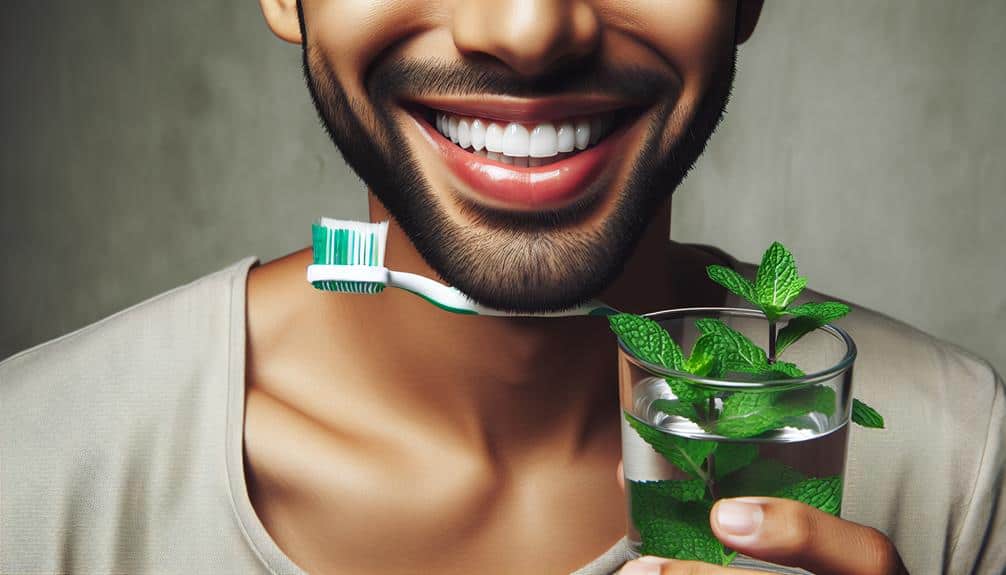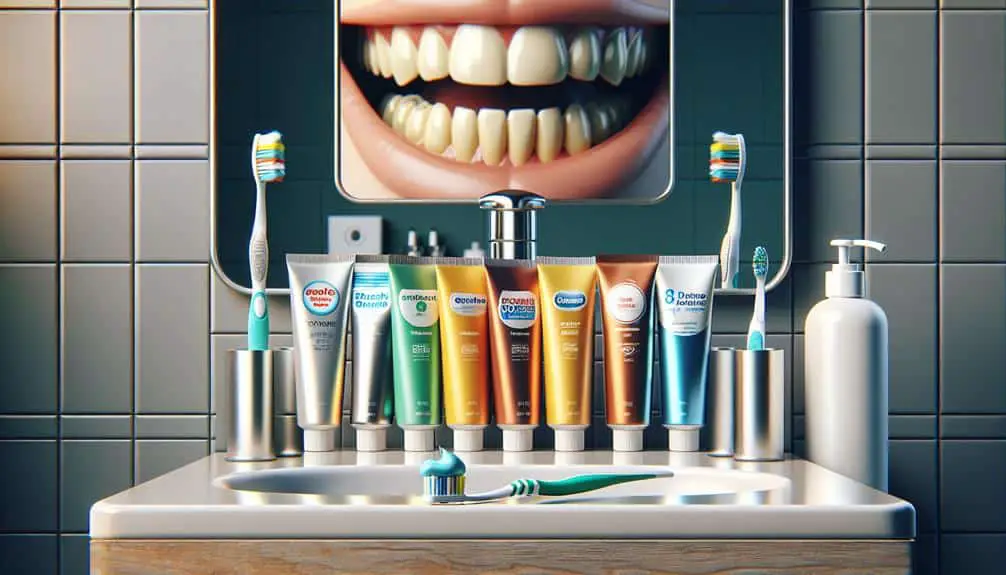To brighten yellow teeth, start by brushing with baking soda to scrub away surface stains, but be cautious to avoid enamel damage. Consider using hydrogen peroxide in safe concentrations to bleach teeth effectively. Try oil pulling with coconut or sesame oil to reduce bacteria and plaque, leading to a whiter smile. Opt for whitening toothpaste and avoid foods like red wine and coffee. For professional results, explore whitening treatments that offer precise application and quicker outcomes. Professional guidance is key to achieving a stunning, white smile.
Key Points
- Brush with baking soda to remove surface stains gently.
- Use hydrogen peroxide for safe and effective bleaching.
- Try oil pulling with coconut or sesame oil for natural whitening.
- Use whitening toothpaste and avoid staining foods for maintenance.
- Consider professional whitening treatments for quick and lasting results.
Brush With Baking Soda
To effectively whiten yellow teeth, consider brushing with baking soda. Baking soda, known for its abrasive properties, can help remove surface stains on teeth, making it a popular choice for natural remedies and DIY solutions. When used correctly, baking soda can gently scrub away plaque and discoloration, revealing a brighter smile.
To utilize baking soda in whitening your teeth, simply wet your toothbrush, dip it into baking soda, and brush your teeth as usual. It's important to remember that baking soda should be used sparingly as excessive use can wear down tooth enamel over time. Additionally, it's recommended to limit the use of baking soda to a few times a week to prevent any potential damage to your teeth.
Incorporating baking soda into your oral hygiene routine can be a cost-effective and natural way to help whiten your teeth. However, it's essential to consult with your dentist before making any significant changes to your dental care regimen.
2. Use Hydrogen Peroxide
Consider incorporating hydrogen peroxide into your oral care routine for its potential teeth-whitening benefits. Hydrogen peroxide is a common bleaching agent that can help lighten the color of your teeth. When utilizing hydrogen peroxide for teeth whitening, it's important to prioritize safety. Make sure you're using a safe concentration suitable for oral use, typically around 3%. Higher concentrations can result in irritation and damage to your teeth and gums.
To use hydrogen peroxide effectively, you can mix it with baking soda to create a paste. The combination of hydrogen peroxide and baking soda can enhance the whitening effect due to their individual properties. Baking soda is mildly abrasive and can help scrub away surface stains, while hydrogen peroxide acts as a bleaching agent to lighten the color of your teeth.
3. Oil Pulling Technique
To whiten yellow teeth effectively, oil pulling is a technique worth considering. This method involves swishing oil in your mouth to remove bacteria, plaque, and stains. Regular practice, typically for about 10-20 minutes daily, can lead to improved oral health and potentially whiter teeth.
Oil pulling is a simple yet effective way to promote oral hygiene and potentially brighten your smile. It is a natural remedy that can complement your regular dental care routine. By incorporating this practice into your daily regimen, you may experience a fresher mouth and a brighter, whiter smile over time.
Benefits of Oil Pulling
Engage in the ancient practice of oil pulling to experience the myriad benefits it can offer for whitening your yellow teeth. Oil pulling involves swishing oil around in your mouth to improve oral health.
Here are four benefits of oil pulling supported by research:
- Reduces Harmful Bacteria: Oil pulling can help reduce the number of harmful bacteria in your mouth, which may contribute to yellowing teeth.
- Decreases Plaque Formation: By removing bacteria and toxins, oil pulling can decrease plaque formation on teeth, leading to a brighter smile.
- Improves Gum Health: This technique may help improve gum health by reducing inflammation and promoting overall oral hygiene.
- Natural Teeth Whitening: Oil pulling is a natural way to whiten teeth without harsh chemicals, providing a gentle and effective whitening method.
How to Do
For effective oil pulling technique to whiten yellow teeth, begin by choosing a high-quality oil such as coconut or sesame oil.
Oil pulling is a traditional Ayurvedic practice known for its natural remedies and DIY solutions for oral health. To start, take a tablespoon of your chosen oil and swish it around in your mouth for about 15-20 minutes. Make sure not to swallow the oil, as it collects toxins and bacteria from your mouth.
After swishing, spit out the oil into a trash can (to avoid clogging your sink) and rinse your mouth with warm water. Repeat this process regularly to see potential improvements in the color of your teeth due to the oil's cleansing properties.
Frequency and Duration
Consider the recommended frequency and duration for best results when incorporating the oil pulling technique into your oral care routine. Oil pulling is a natural method that can help whiten yellow teeth when done correctly. Here are some key points to keep in mind:
- Whitening Frequency: Aim to practice oil pulling at least 3-4 times a week for noticeable results.
- Duration Matters: For peak effectiveness, swish the oil around in your mouth for 15-20 minutes during each session.
- Consistency is Key: Stick to a regular schedule to see long-term improvements in the whiteness of your teeth.
- Patience is a Virtue: Results may vary, so give it some time before expecting significant changes in tooth color.
4. Try Activated Charcoal
To whiten yellow teeth, incorporating activated charcoal into your oral care routine can be a beneficial method. Activated charcoal is a common ingredient in many charcoal toothpaste products due to its natural teeth whitening properties. It operates by binding to compounds that cause stains on the teeth, aiding in their removal and brightening your smile.
When using charcoal toothpaste, it's crucial to do so correctly to avoid damaging your enamel. Gently brush your teeth with the charcoal toothpaste for about two minutes, ensuring you cover all surfaces thoroughly. Remember not to scrub too vigorously, as activated charcoal can be abrasive if used aggressively.
Several studies have demonstrated that activated charcoal can help effectively eliminate surface stains from the teeth. However, it's important to use it in moderation and not as a replacement for regular toothpaste. Integrating activated charcoal into your oral care routine a few times a week can be a safe and natural way to help whiten yellow teeth.
5. Eat Strawberries
Eating strawberries can contribute to whitening yellow teeth due to their natural malic acid content, which can help remove surface stains and brighten your smile. These delicious fruits offer a natural remedy for achieving a brighter, whiter smile without harsh chemicals. Here are four reasons why incorporating strawberries into your diet may help whiten your teeth:
- Fruit acids: The malic acid found in strawberries acts as a natural astringent to remove surface stains from your teeth.
- Vitamin C: Strawberries are rich in vitamin C, which can help break down plaque causing discoloration on your teeth.
- Enzymes: The enzymes present in strawberries can help remove debris and bacteria from your mouth, contributing to a cleaner and brighter smile.
- Antioxidants: Antioxidants in strawberries may help prevent tooth decay and maintain overall oral health.
6. Rinse With Apple Cider Vinegar
To further enhance the whitening effects on yellow teeth, incorporating the practice of rinsing with apple cider vinegar can be beneficial. Apple cider vinegar is known for its natural remedies and benefits for oral health. The acetic acid in apple cider vinegar has antibacterial properties that can help in removing stains and whitening teeth. Its acidic nature can also aid in breaking down plaque and tartar buildup, which may contribute to discoloration.
When using apple cider vinegar as a rinse, dilute it with water to reduce its acidity and prevent damage to the tooth enamel. Mix one part apple cider vinegar with two parts water and swish the solution around in your mouth for about 30 seconds. After rinsing, be sure to brush your teeth to remove any residual acid from the vinegar.
Incorporating apple cider vinegar into your oral hygiene routine can be a natural and effective way to whiten yellow teeth while promoting good oral health. Remember to use it in moderation to avoid any adverse effects on your teeth.
7. Use Whitening Toothpaste
Consider incorporating whitening toothpaste into your daily oral care routine to help combat yellowing teeth. Whitening toothpaste can be a convenient and effective way to improve the color of your teeth, but it's crucial to use it correctly to see the best results.
Here are some tips to help you make the most out of your whitening toothpaste:
- Choose a reputable brand: Look for whitening toothpaste that has been approved by dental associations for safety and effectiveness.
- Follow instructions: Use the toothpaste as directed on the packaging to make sure you're using it correctly.
- Pair with regular dental check-ups: Incorporate whitening toothpaste into your oral care routine in addition to regular dental visits for a thorough approach to oral health.
- Enhance with proper flossing technique: Combine whitening toothpaste with proper flossing technique to maintain overall oral hygiene and prevent staining between teeth.
8. Avoid Staining Foods
To maintain a bright smile, be mindful of the foods that can stain your teeth. Certain foods and beverages can contribute to teeth discoloration over time. Red wine, coffee, tea, and dark sodas are common culprits known for staining teeth due to their high chromogen content. Berries, such as blueberries and blackberries, can also leave stains on your enamel. If you consume these staining foods, it's advisable to rinse your mouth with water afterward to help reduce the impact on your teeth.
Furthermore, teeth sensitivity can be exacerbated by consuming foods that are either too hot or too cold. This sensitivity can make it uncomfortable to consume certain foods and drinks, further impacting your overall oral health. Regular dental checkups are essential to monitor the health of your teeth and address any sensitivity issues promptly. Your dentist can provide guidance on managing sensitivity and recommend suitable products to alleviate discomfort, ensuring your whitening efforts are effective and comfortable.
9. Professional Whitening Treatments
If you're looking for a more intensive approach to whiten your teeth, consider professional whitening treatments. These treatments are typically conducted at a dental office and involve in-office whitening sessions.
Expert teeth bleaching procedures administered by professionals can help achieve significant whitening results.
Dental Office Treatments
Professional whitening treatments performed in a dental office are highly effective in removing stubborn stains and achieving significant improvements in the brightness of yellow teeth. These treatments offer various benefits such as precise application by trained professionals, ensuring even whitening results. Additionally, the use of high-concentration bleaching agents in dental settings leads to quicker and more noticeable outcomes. Dental office treatments are advantageous as they can be tailored to individual needs, addressing specific concerns like sensitivity. When considering these procedures, reflecting on cost implications and whether insurance coverage may apply. Consulting with your dentist regarding the financial aspects can help you make an informed decision about undergoing professional whitening treatments.
- Precise application by trained professionals
- Quick and noticeable outcomes with high-concentration bleaching agents
- Tailored treatments for individual needs
- Cost considerations and insurance coverage
In-Office Whitening Sessions
Moving from dental office treatments to in-office whitening sessions seamlessly enhances the brightness of yellow teeth through specialized procedures carried out by trained dental professionals. Before the treatment, a pre-treatment consultation is essential to assess your oral health and determine the best whitening approach.
In-office whitening sessions often provide quicker and more noticeable results compared to at-home treatments, though they might be more costly. The cost comparison is important when deciding on the treatment method.
After the session, following proper aftercare instructions is vital to maintain the results. In-office whitening can offer long-term results, especially when coupled with good oral hygiene practices. Consider this option for efficient and effective yellow teeth whitening under professional supervision.
Expert Teeth Bleaching
Enhance the brightness of your yellow teeth effectively with expert teeth bleaching treatments carried out by trained dental professionals. Expert teeth bleaching provides a powerful solution for stubborn discoloration, delivering noticeable results in a controlled and safe environment.
Here are four key benefits of opting for professional whitening treatments:
- Customized Approach: Dental professionals tailor the treatment to your specific needs, ensuring effective results.
- Stronger Whitening Agents: Expert treatments use higher concentrations of bleaching agents for more significant whitening outcomes.
- Reduced Risk of Sensitivity: Professionals monitor the process, minimizing the risk of tooth sensitivity often associated with bleaching.
- Long-lasting Results: Professional whitening can provide longer-lasting effects compared to DIY bleaching methods or natural teeth whitening options.
10. Maintain Good Oral Hygiene
To maintain good oral hygiene for whiter teeth, consistent brushing and flossing are essential. Flossing regularly is important as it helps remove plaque and food particles that brushing alone may miss. When plaque builds up, it can lead to yellowing of the teeth. By flossing at least once a day, you can greatly improve your oral hygiene and contribute to a brighter smile.
Additionally, limiting sugar consumption is crucial for maintaining white teeth. Sugary foods and drinks can fuel the growth of bacteria in your mouth, which produce acids that erode tooth enamel. This erosion can expose the yellowish dentin underneath, causing teeth to appear yellow. By reducing your sugar intake, especially sugary snacks and sodas, you can help protect your teeth from discoloration.
Frequently Asked Questions
Can Whitening Treatments Like Baking Soda or Hydrogen Peroxide Damage Tooth Enamel Over Time?
Using baking soda or hydrogen peroxide for whitening teeth may pose risks to enamel over time. To protect enamel, consult a dentist. Dispelling whitening myths is essential. Enamel protection is vital for maintaining healthy teeth.
How Often Should Oil Pulling Be Done for Effective Teeth Whitening?
For effective teeth whitening through oil pulling, consider doing it daily or at least a few times a week. Consistent frequency can lead to benefits like improved oral health and potential whitening results, but be mindful of any potential drawbacks.
Are There Any Risks or Side Effects Associated With Using Activated Charcoal for Whitening?
When using activated charcoal for whitening, be mindful of sensitivity concerns. Consider alternative methods to avoid potential risks. Monitor long-term effects and seek professional advice. Prioritize your dental health and well-being above quick fixes.
Can Eating Strawberries Really Help Whiten Teeth, and if So, How Many Should Be Consumed?
Eating strawberries can help whiten teeth due to malic acid. Consume 1-3 strawberries daily. To prevent tooth enamel erosion, rinse mouth after eating acidic foods, use a straw, and wait 30 minutes before brushing teeth.
How Long Should Apple Cider Vinegar Be Rinsed in the Mouth for Noticeable Whitening Effects?
For noticeable whitening effects, rinse apple cider vinegar in your mouth for 1-2 minutes. The acidity level in vinegar benefits by breaking down stains. Consistency is key. Remember not to overuse as excessive acidity can harm your tooth enamel.
Conclusion
To wrap up, integrating these 10 tips into your oral hygiene routine can assist in whitening yellow teeth and enhancing your overall dental health.
For instance, Sarah, a 35-year-old woman, observed substantial enhancement in the color of her teeth after utilizing whitening toothpaste and refraining from staining foods for just two weeks.
Remember to consult with a dentist before attempting any new whitening treatments to confirm they're safe and effective for you.



